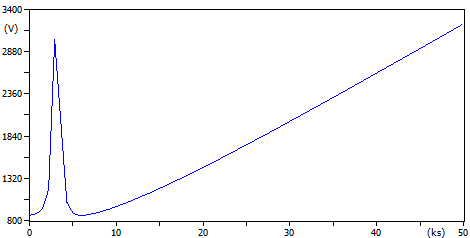The fun is in determining the transfer function (TF) symbolically otherwise you don't know what elements contribute to the resonant frequencies. You can use the brute-force analysis to determine this TF - good luck with that - or use the fast analytical circuits techniques or FACTs described in the book I published. By determining the time constants of this circuit by inspection (no algebra at all) and assembling them at the end, you determine the TF of this 3rd-order network.
The various time constants are here:

and the final transfer function is here:

So there are three zeroes and three poles. The more difficult exercise is to factor this beast in a second-order polynomial multiplied by a low-frequency pole and zero. Once this is done, you can determine analytically the resonant frequencies you want:

This is an approximated expression and you can see a dc attenuation of 48.2 dB and a notch appearing at 6 kHz.
Addendum
To show you the principle behind the small sketches, I have added below the steps I used to determine the denominator poles and the high-frequency gains. For the poles, you reduce the excitation \$V_{in}\$ to 0 V (replace the symbol by a short circuit) and you temporarily disconnect the considered energy-storing element. You then "look" through its connecting terminals to see the resistance \$R\$. Then, depending if it is a capacitor or an inductor, you have \$\tau=RC\$ or \$\tau=\frac{L}{R}\$. With passive circuits like in this example, you can inspect the circuit and simply find the resistance by reading the arrangement: no algebra and easy corrections if necessary.
For the numerator, you can either go through a null double injection (NDI) or determine high-frequency gains \$H\$. These high-frequency gains allow me to re-use the natural time constants (the \$RC\$ and \$\frac{L}{R}\$ values) to determine the numerator. Simply put, it is an excellent means to "see" if any energy-storing element contributes a zero: place the considered element in its high-frequency state (a short for a capacitor or an open circuit for an inductor) and check if there is a non-zero gain \$H\$ linking \$V_{in}\$ to \$V_{out}\$. If there is a gain, meaning that the stimulus in this mode can propagate and create a response, the tested element contributes zero. Without doing anything on this circuit, you can immediately count 3 zeros there.

The other difficult thing is to factor the raw polynomial into meaningful expressions where poles, zeroes and resonant frequencies appear. It is not always easy as factorization depends on the time constants and how they compare with each other. For instance, it seems possible to define three separated poles considering three distinct positions. The plots show a fairly good approximation with the full-blown expression:

I recommend to read this document written by Prof. Erickson from Colorado Edu which explains in details how to do it.











